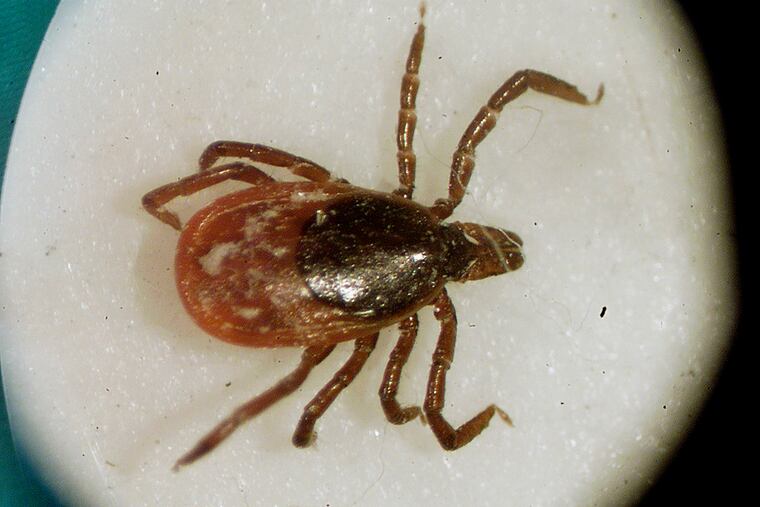N.J. has at least 11 tick species, and some are making us sick
A Rutgers-led team has confirmed 11 tick species living in New Jersey, including two invasive species, in what it hopes is the start of an effort to control the spread of the arachnid, responsible for the rapid spread of Lyme and other diseases.

A Rutgers-led team has identified 11 tick species living in New Jersey, hoping to foster a statewide effort to control the spread of the arachnid responsible for Lyme and other diseases.
Scientists involved in the study believe it is the first time a formal tally has been made in the Northeastern United States.
Two of the identified species are invasive and may have found a permanent home in the state, at least in part because climate change has made it warm enough for them to survive.
Ticks spread pathogens that can cause diseases in humans, livestock, and pets. James Occi, a Ph.D. candidate at Rutgers’ Center for Vector Biology, said he hopes the work leads to a standardized tick surveillance program. That would help researchers more accurately assess which tick-borne diseases might be present and find better ways to control the pests.
The scientists searched scholarly databases, the United States National Tick Collection curated by the Smithsonian Institution, and reached out to other universities in the Northeast to derive their findings.
“There hasn’t been any kind of systematic surveillance,” said Dina M. Fonseca, an associate professor at Rutgers.
She noted the tick blitz, a census of ticks in all 21 counties, that Rutgers started last year as the first step. The census showed, for example, that lone star ticks, which can spread disease-causing pathogens, are more widespread across the state than ever before.
New Jersey also drew national focus two years ago when an exotic Asian tick, Haemaphysalis longicornis, also known as the longhorned tick, was confirmed to be present. It is one of the two invasive species from other countries found to be spreading throughout the state. Other research suggests the longhorned tick has likely been present since 2013. The longhorned tick has been a threat to animals and people in other countries — but that’s not been the case so far in New Jersey.
The brown dog tick, the second invasive species, can infest dog kennels and homes, carrying pathogens that cause canine and human diseases.
Fonseca said other ticks have moved north from the Southern United States in recent years, such as the Gulf Coast tick, which can transmit Rickettsia parkeri rickettsiosis, a form of spotted fever, to people. The Gulf Coast tick isn’t present in New Jersey yet, but the authors of the study believe it will eventually arrive.
Although it’s hard to say exactly why a tick moves into a certain area, Fonseca said climate change could be having an impact.
"So we’re seeing a moving north of ticks that many would argue is related to warmer temperatures,” Fonseca said. “Before that, they wouldn’t survive.”
She said ticks are one of the most common carriers of vector-borne diseases in the world. Vector borne means an infection is transmitted to humans by other animals or insects or, in this case, arachnids.
Fonseca said New Jersey had 4,000 diagnosed cases of Lyme disease, which is vector borne, last year. She said, on a per capita basis, Lyme disease incidence rivals that of cancer in New Jersey.
Nationally, there are up to 300,000 cases of Lyme disease each year. Overall, the number of tick-borne diseases has tripled in the United States in the last 10 years.
For example, the lone star tick, long present in New Jersey, presents a significant public health threat because it feeds on pets, people, and wildlife. It results in thousands of cases of Ehrlichia chaffeensis in dogs each year. And the Centers for Disease Control and Prevention says it likely transmits Heartland virus, presenting an emerging threat. Though there were only 40 cases reported as of last year, those diagnosed with Heartland virus have fever, fatigue, decreased appetite, headache, nausea, diarrhea, and muscle or joint pain.
As a result, Fonseca said, it’s important that the state — and nation— get a better idea of how big the tick population is and where species are present.
Here’s a rundown of ticks present in New Jersey (the common name is listed if there is one): lone star, winter, American dog, rabbit, Asian longhorned, brown dog, blacklegged, Ixodes brunneus, Ixodes cookei, Ixodes dentatus, and Ixodes texanus.
Five other species of ticks have been reported in New Jersey, but not verified.